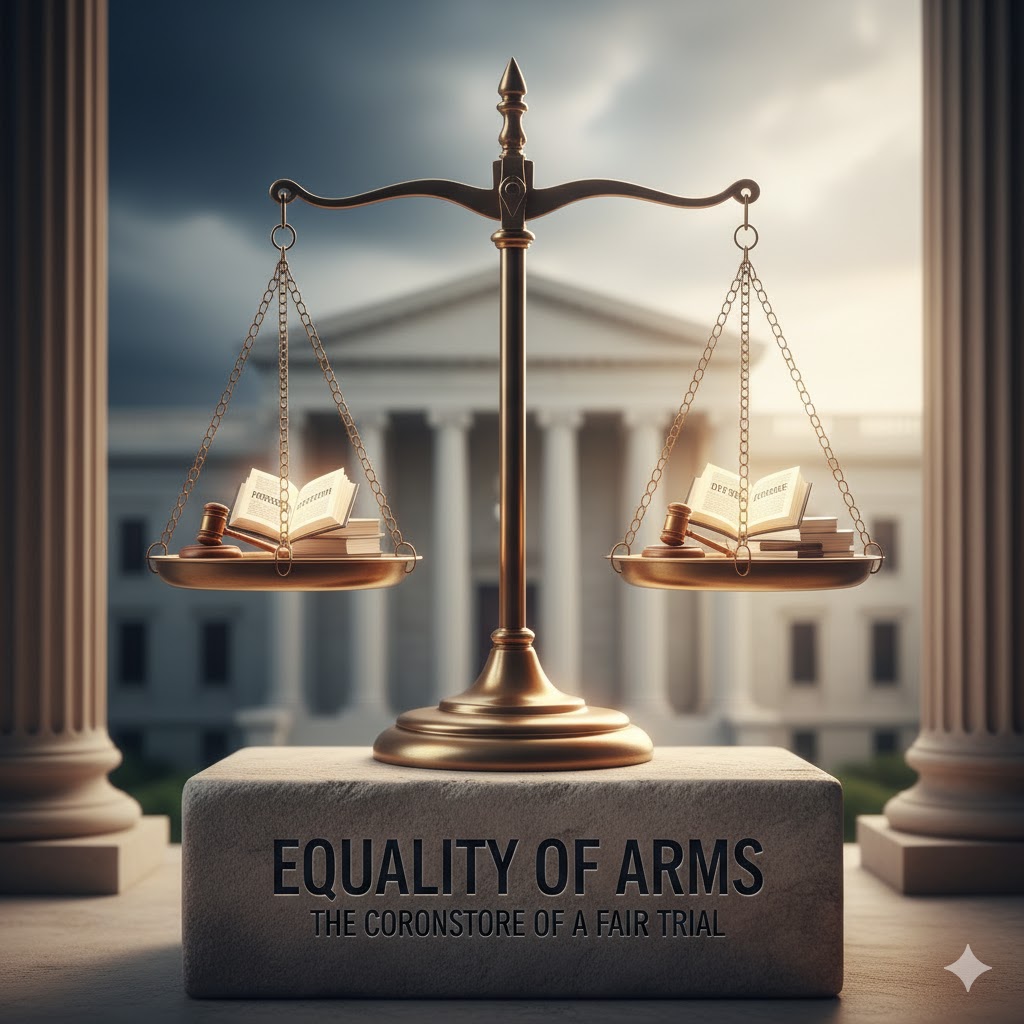Equality of Arms
Equality of Arms is a foundational principle of fair trial rights, ensuring that no party in legal proceedings is placed at a substantial or unfair disadvantage. Deeply embedded in both national constitutions and international human rights instruments, this doctrine has been continuously shaped and strengthened through landmark jurisprudence across the world.
The Doctrine of Procedural Fairness
Equality of arms denotes procedural fairness between opposing parties in legal disputes, particularly in criminal trials. It mandates that both the prosecution and the defense have an equal and effective opportunity to present their case under conditions that do not unduly favour one side. Far from being a mere procedural formality, this principle lies at the heart of the right to a fair trial, reinforcing judicial legitimacy and public trust in the justice system.
Theoretical and Practical Value
- Correct Trial Outcomes: Procedural equality enhances the likelihood of accurate and just verdicts.
- Dignity and Respect: Equal treatment reaffirms the rights-bearing status of all individuals before the law.
- Good Governance: Fair trials strengthen institutional integrity and public confidence in justice systems.
Legal and Juridical Foundations
International Law
| Instrument | Provision | Impact on Equality of Arms |
|---|---|---|
| European Convention on Human Rights (ECHR) | Article 6(1) | Guarantees a fair and public hearing, interpreted by the ECtHR to include equality of arms as a core component. |
| International Covenant on Civil and Political Rights (ICCPR) | Article 14 | Affirms equality before courts and tribunals, requiring a fair procedural balance. |
| Rome Statute (ICC) | Procedural & Evidentiary Framework | Explicitly embeds the principle, ensuring parity between prosecution and defense teams. |
Key International Case Law
- Dombo Beheer B.V. v. Netherlands (ECHR, 1993): Denying one party the right to examine witnesses was held to violate equality of arms.
- Prosecutor v. Tadić (ICTY): Affirmed that both sides must have comparable access to evidence and procedural mechanisms.
- Šešelj v. ICTY (2013): The Appeals Chamber emphasized that even in contempt proceedings, equality of arms must be preserved.
National Frameworks
| Jurisdiction | Legal Basis | Manifestation of Equality of Arms |
|---|---|---|
| United States | Sixth Amendment (Right to Counsel) & Due Process Clauses | Upheld collectively through judicial interpretation. Gideon v. Wainwright (1963) and Ake v. Oklahoma (1985) exemplify the principle. |
| United Kingdom | Human Rights Act, 1998 | Incorporates ECHR protections, making equality of arms directly enforceable in domestic courts. |
| India | Article 21 (Right to Life and Personal Liberty) | Judicially expanded to include the right to a fair trial and procedural fairness. Zahira Habibullah Sheikh v. State of Gujarat (2004) underscores equal opportunity to present evidence. |
Contemporary Challenges and Systemic Gaps
Despite its fundamental status, equality of arms faces persistent challenges, often exacerbated by resource disparities and procedural inefficiencies:
- Legal Aid Shortfalls: Cuts to legal aid funding—especially in the UK and under-resourced jurisdictions in the US and India—severely limit the ability of indigent parties to mount effective defenses, creating immediate procedural imbalance.
- Prosecutorial Discretion and Power: In the US, the prevalence of plea bargaining and expansive prosecutorial authority can pressure defendants into accepting disadvantageous terms.
- International Tribunals: The ICTY, ICTR, and ICC have struggled to achieve full parity between well-funded, state-supported prosecution teams and defense counsels with limited resources.
- Systemic Bias and Backlogs: In India, systemic delays, case overloads, and social biases disproportionately impact marginalized communities, undermining timely and equitable access to justice.
Barriers to Equality of Arms
The ideal of equality of arms is frequently weakened by structural and procedural imbalances across legal systems. While it remains a cornerstone of fair trial rights, in practice it often exists more as an aspiration than a reality.
At the national level, the imbalance is evident through underfunded legal aid systems, prosecutorial dominance, and restricted access to evidence. In India, overburdened and underpaid public defenders and heavy caseloads limit effective representation. In the United States, plea bargaining pressures and sentence disparities reduce genuine parity. In the United Kingdom, delayed or incomplete evidence disclosure continues to hinder the defense’s preparation.
At the international level, tribunals such as the ICTY and ICTR have historically struggled with unequal funding, linguistic hurdles, and difficulties in securing witnesses. In politically sensitive cases—such as those involving national security or terrorism—closed hearings, undisclosed evidence, and executive interference further erode transparency and the true essence of equality of arms.
The Imperative for Reform
Upholding equality of arms demands proactive, systemic reform, not passive adherence:
- Strengthen Legal Aid: Guarantee timely, competent, and adequately funded legal representation for all indigent or disadvantaged parties.
- Judicial Oversight and Training: Equip judges to recognize and correct procedural disparities in real time, ensuring substantive fairness throughout proceedings.
- Enhance Resource Parity: Especially in high-profile or complex cases, ensure defense teams have equitable access to expert assistance, investigations, and technology.
- Promote Transparency: Employ digital tools and independent oversight to ensure openness in evidence-sharing and case management.
Conclusion
The principle of Equality of Arms is far more than a procedural requirement; it is the vital current that animates the entire justice system. It fundamentally shapes whether legal processes are truly impartial, judicial rulings carry genuine authority, and individual rights are effectively safeguarded. Preserving this principle requires unwavering vigilance, sustained institutional reform, and a deep commitment to the dignity and fairness owed to every participant in the pursuit of truth. Hence, ‘equality of arms’ is not merely a legal principle but the lifeblood of justice.






